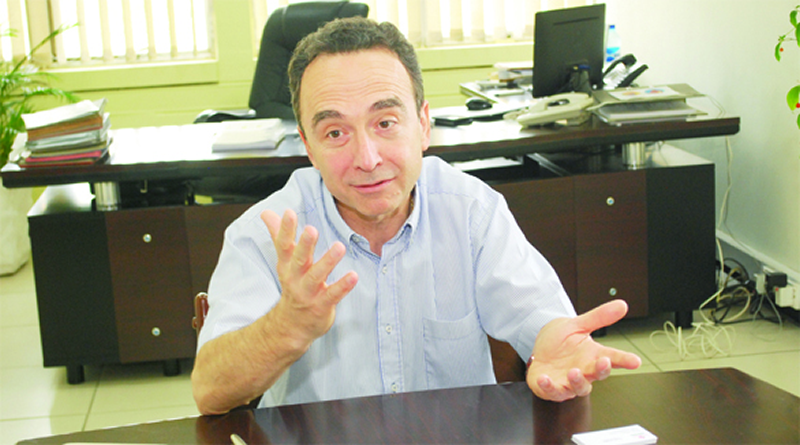Housing deficit: Dry construction, way out —Nigerite MD
Mr. Frank Le-Bris is the Managing Director of Nigerite Limited, manufacturers of building materials. In this interview, he spoke about the company’s dry construction initiative and sundry issues. Excerpts:
Nigerite Limited has been at the forefront of developing building solutions tailored towards solving Nigeria’s housing deficit. How did your organisation arrive at the dry construction technique?
First, we set up a new organisation. Then we set up a new business unit for dry construction because in the past all our salesmen were together. So, we started from the scratch and hired new people, mostly architects and engineers who worked exclusively on dry construction. Apart from that, we also got support from our Nigerite partner; Etex group, which is involved in the production of dry construction in Europe, Asia and South America. Our people got trained in Belgium and we also got some benchmarks from Etex, South America where people massively went from classical brick and mortar construction to dry construction. Altogether, we created the added value for Nigeria and for Nigerite.
Dry construction has been in use in the developed world for some time now. Why are you bringing it to Nigeria at this time?
Well, it could have been earlier, but the markets are slightly different, so we have to wait a bit more for a time when people can welcome dry construction. When we looked at projects, especially on Lagos Island and Federal Government-financed projects, we saw some new interests and that is why we started it.
How well have Nigerians embraced the dry construction technique?
Change is always difficult for everybody. When we want to change something, it will take time because every human being prefers routine. I will say the classic Nigerian market is still 95 per cent brick and mortar. There is some level of reluctance because you will think that if you start with dry construction, your building will not last for years, so you are a bit reluctant. However, professionals like architects, contractors and so on are more open to try new technologies. Besides, the dry construction is coming from architects like them.
Your organisation, in partnership with Selavip and Etex, has just dedicated 24 housing units using dry construction. Could you briefly tell us what the project was all about?
It was financed by Selavip and it was a CSR project for Etex. Etex also directly financed a lot of things and Nigerite gave a high discount for the building materials. Some other organisations are also involved. It was a very quick project. We started discussing the financing last year between November and December, but the project proper started in March this year and ended two months after. It was 24 units of one-bedroom flats with living room and the cost is between N1.6 million and N1.7 million, but it is being sold to people at about N360, 000. So, it is a way of developing a new house in a very short time. I will say that the walls, roofing and ceiling are made of what we call cladding, which is made of a special formula, Kalsi plasterboards. So the flooring was left to the new owner to do.
Do you have any intention of reducing the cost of purchasing dry construction so that it will be affordable for an average Nigerian?
We are working on it every day. First, we will reduce the cost of boards because we produce here in Nigeria. The boards were formerly imported from other countries, mainly Indonesia. We are working daily on the process to decrease the cost but I insist; it will never be against quality.
What is Nigerite doing about reducing resistance towards dry construction?
We are still talking about few months, and 24 small houses. At a point in South America, like in Colombia, Peru, Chile and so on, people were initially reluctant to use the system. So, they would build a house and when they want to add another floor, they were looking for something cheaper and faster and then they started using the dry construction. Dry construction is now very popular in South America because people see that it works. I must tell you that it will take time, years probably. It is important to stress the point that dry construction is not in competition with brick and mortar. Instead, it is complementary to it. For example, the basis, which is the basement of the house, is a brick and mortar, first floor and ceiling, dry construction cement boards. There is a future for it. In the next 10, 20 to 40 years from now, we will see more and more full houses. I see Nigerite being more involved in Corporate Social Responsibility (CSR) projects linked to dry construction system to help people, state and Federal Government to build houses.
Earlier, you mentioned that the use of dry construction is limited to highbrow areas in Lagos. What is Nigerite doing to expand the market so that people in other parts of the country can access it?
We organised launching campaigns to explain the advantages of Kalsi dry construction. We trained our distributors and we trained carpenters and technicians too. On top of that, each distributor will get a new point of sales to display the new product. We also give this information to architects and contractors. We also took part in housing exhibitions here in Lagos and in Abuja. We built a small house in Abuja. It is about explaining, training and showing.
Is there any engagement with the Federal Ministry of Housing on using dry construction to solve the deficit housing problem in this country?
There is none yet. We are ready to cooperate with the government. We have big projects with state governments like Osun State in what we call Osun schools. We also have the one we call the Samsung Centre project in Ekiti State. I also hear of some interest from the Bayelsa or Enugu region for dry construction at the local government level.
How do you cope with competition, especially in terms of price?
Competition is good. In fact we are not threatened. The more competitors there are in a new market, the better. That way, people will be trained and they will be better informed. It is good for the market. It will expand it. For me, the strategy for Nigerite is clear. It should be innovative. We have been coping with competition that way for the past 55 years.
What challenges did Nigerite encounter in developing dry construction?
I will say the challenges are around fake products. If we talk about dry construction, we have two types of boards. First are the cement boards which have no problem with faking because we are really the pioneer for it. If, however, you talk about plaster boards, you have a lot of fake products imported from China and Asia. They are nothing compared to the boards we import from the Etex Group. For me, I’ll say it is a challenge because with fake products, prices are very low and this is quite difficult for us to compete in plaster boards and that was why I don’t see a high development of production of plasterboard in Nigerite in the next year. We’ll concentrate on walls, floor, roofing and ceilings.
How is Nigerite planning to surmount these challenges?
What we plan is to extend our network of distributors. Right now, we have a very dedicated network of distributors mainly dedicated to cement boards, ceilings and roofing. For dry construction, all the cement boards are manufactured here in Nigeria and are sold through our distributors. The future for me is what I call a one-stop shop for all building solution.
Recently, you mentioned that work is on-going on a new plant. When will operation start at the plant?
Operation is expected to start at the new plant in November or December and it will be officially launched before the beginning of next year. We want to be sure about the product quality and production flow before launching it officially.
We have seen the launch of Prestige ceil and Legend ceil patterned ceilings from Nigerite this year. What else is the Nigerian market expecting from Nigerite?
We are currently working on a new pattern for the embossed ceiling category and it will be released at the end of the year. With Prestige ceil and Legend ceil, I am very happy because they are really beautiful. You can expect a wider range of our Solo Xtra roofing brand. You can also expect a lot of new colours. We’ll have what we call two colours which have a certain effect and also the solo Xtra roofing sheets with only one colour. We could have chocolate brown, grey and some others. We are also working on widening our range of Cretetiles roofing tiles to have at least three new models by the end of the year. One will be produced here in Nigeria, and the other two, for starters will be produced in South Africa and in Italy.
How has Nigerite managed to maintain a steady growth despite the harsh economic situation?
The secret is to listen to customers. The secret is also to train carpenters to team up with distributors. I am talking about for a long time. It is important to feel the pulse of the market and to liaise with the main actors in the market. On top of that, Nigerite is a part of the Etex Group and I will say there has never been a time that Nigerite has ever compromised on quality. Over the years, we are still very eager to keep this going because the name Nigerite itself has been associated with good quality.
What is your message to engineers, architects and other stakeholders in the building environment especially on the use of dry construction?
Well, I will say that architects should be ready to be trained by us. Our aim is to embrace the new methods of dry construction then we will share it with architects. So they could expect to be trained and supported on any project. We will also intensify our efforts on that. I will like to add that dry construction is a complementary business to the brick and mortar business. We are not competing with carpenters or bricklayers or regular workers. We train them. We are not here to take the job of these people but to increase it.
Final word on dry construction?
I will like people to know that dry construction turns the building process into an industrial process. It is quicker, faster and cheaper. I will also like that they understand that the quality is there. They should not be worried about how long the house will remain standing because it will last for years. It is something that will allow us to build houses quicker and help the country resolve housing deficit.




